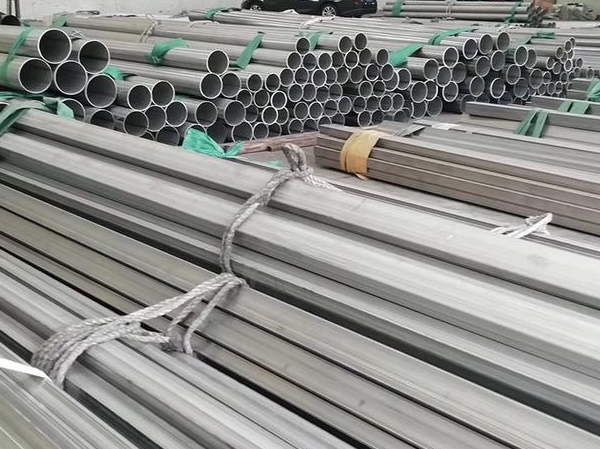What is stainless steel pipe?
Stainless steel pipe (SS pipe) is a hollow long cylindrical steel that is not easy to rust. Its main scope of application is used as a pipeline for conveying fluids. It is widely used in industrial pipelines such as petroleum, chemical industry, medical treatment, food, light industry, mechanical instruments, etc. Mechanical structural parts, etc. The stainless steel pipe is made of acid-resistant and heat-resistant steel billets, which are heated, pierced, sized, hot-rolled, and cut.

Classification of stainless steel pipes:
According to the forming process, stainless steel pipes are mainly divided into two basic categories: stainless steel seamless steel pipes and stainless steel welded steel pipes (seamed steel pipes).
According to the outer diameter and shape of steel pipes, they can be divided into round pipes and special-shaped pipes. Round steel pipes are widely used, but there are also some special-shaped steel pipes such as square, rectangular, semicircular, hexagonal, equilateral triangle, and octagonal.
For steel pipes under fluid pressure, hydraulic tests and radiographic flaw detection are required to check their pressure resistance and quality. It is qualified if no leakage, soaking or expansion occurs under the specified pressure. Some steel pipes are also tested according to standards or requirements of the buyer. Hemming test, flaring test, flattening test, etc.
Weight calculation formula:
[(outer diameter-wall thickness)*wall thickness]*0.02491=kg/m (weight per meter)
Classification of grades of stainless steel pipes:
201 Series—Chromium-nickel-manganese austenitic stainless steels.
300 Series—Chromium-nickel austenitic stainless steels.
301—Good ductility, used for forming products. It can also be hardened by mechanical processing. Good weldability. Wear resistance and fatigue strength are better than 304 stainless steel.
302—The corrosion resistance is the same as that of 304, and the strength is better because of the relatively high carbon content.
303—By adding a small amount of sulfur and phosphorus, it is easier to cut than 304.
304—General model; that is, 18/8 stainless steel. The GB grade is 0Cr18Ni9.
309—Better temperature resistance than 304.
316—After 304, the second most widely used steel grade, 316 stainless steel pipe is mainly used in the food industry and surgical equipment, adding molybdenum to obtain a special corrosion-resistant structure. Because it has better resistance to chloride corrosion than 304, it is also used as "marine steel". SS316 is usually used in nuclear fuel recovery units. Grade 18/10 stainless steel is also generally suitable for this application level.
321—Similar to 304 except that the risk of material weld corrosion is reduced due to the addition of titanium.
400 Series—Ferritic and martensitic stainless steels.
408—good heat resistance, weak corrosion resistance, 11% Cr, 8% Ni.
409—The cheapest model (British and American), usually used as an automobile exhaust pipe, is a ferritic stainless steel (chrome steel).
410—Martensitic (high-strength chromium steel), good wear resistance and poor corrosion resistance.
416—The addition of sulfur improves the processing properties of the material.
420 - "Knives grade" martensitic steel, similar to the earliest stainless steels such as high chromium brinell steels. It is also used for surgical knives and can be made very shiny.
430—Ferritic stainless steel, for decoration, such as for car accessories. Good formability, but poor temperature resistance and corrosion resistance.
440—High-strength cutting tool steel, with slightly higher carbon content, higher yield strength can be obtained after proper heat treatment, and the hardness can reach 58HRC, which belongs to the hardest stainless steel. The most common application example is "razor blades". There are three commonly used models: 440A, 440B, 440C, and 440F (easy to process).
500 Series—Heat resistant chromium alloy steel.
600 Series—Martensitic precipitation-hardening stainless steels.
630—The most commonly used type of precipitation hardening stainless steel, usually also called 17-4; 17%Cr, 4%Ni.
Production process of stainless steel pipe:
Production process of stainless steel seamless pipe
Round steel preparation - heating - hot rolling piercing - head cutting - pickling - grinding - lubrication - cold rolling processing - degreasing - solution heat treatment - straightening - pipe cutting - acid Washing - finished product inspection.
Production process of stainless steel welded pipe
Raw material--slitting--welding pipe making--repairing--polishing--inspection (printing)--packing--shipping (warehousing) (decorative welded pipe)
Raw material--slitting--welding pipe making--heat treatment--straightening--straightening--repairing--pickling--hydraulic test--inspection (printing)--packing--shipment (warehouse ) (welded pipe for industrial piping)
Go here to learn more about " Carbon Seamless Tube vs Stainless Seamless Tube "


